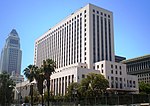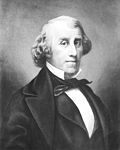United States Post Office and Courthouse (Los Angeles, California, 1910)

The second Los Angeles federal building in Los Angeles County, California, more formally the United States Post Office and Courthouse, was a government building in the United States was designed by James Knox Taylor ex officio and constructed between 1906 and 1910 on the block bounded by North Main, Spring, New High, and Temple Streets. The location was previously known as the Downey Block.The second federal building was made of “red sandstone on a white granite base” and cost $500,000. Upon completion, the six-story building housed a post office, Southern District of California courtrooms, customs offices, and revenue offices. The "impressive" post office was a marble-lined hall within the building. The circuit court moved into the building in September 1910.However, the population of Los Angeles grew rapidly in the early part of the 20th century, and a larger building was needed to serve the courts and federal agencies. The second federal building was razed in 1937 by the Works Progress Administration to clear the site for the Spring Street Courthouse.The street address of this building may have been 201 N. Main Street.
Excerpt from the Wikipedia article United States Post Office and Courthouse (Los Angeles, California, 1910) (License: CC BY-SA 3.0, Authors, Images).United States Post Office and Courthouse (Los Angeles, California, 1910)
North Spring Street, Los Angeles Chinatown
Geographical coordinates (GPS) Address Website Nearby Places Show on map
Geographical coordinates (GPS)
| Latitude | Longitude |
|---|---|
| N 34.055 ° | E -118.2414 ° |
Address
Spring Street Courthouse (U.S. District Court - Central California Western Division - Spring Street Courthouse)
North Spring Street 312
90012 Los Angeles, Chinatown
California, United States
Open on Google Maps







